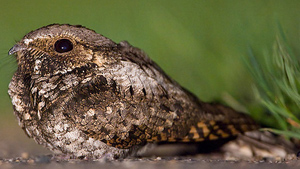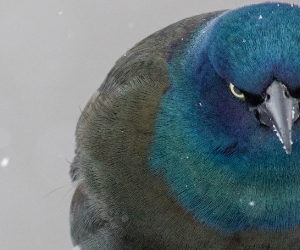Species Spotlight: Eastern Whip-poor-will
Get to know some of the species at risk in the Lac Deschênes IBA with the Species Spotlight, aka “Sp-Spot”. Today meet the: Eastern Whip-poor-will

Eastern Whip-poor-will
Scientific Name: Antrostomus vociferus
SARA and COSEWIC Status: Threatened
Taxonomic Group: Birds
Size: length of 22-27 cm, wingspan of 45-50cm, weight 42-59 g
The Whip-poor-will is a nocturnal bird of medium size. It has a large flattened head with big eyes and a small bill. The corner of their mouth has long, fine feathers that serve as sensory bristles. Their wings are rounded and do not reach the tip of the tail when folded. Their colour is a scattered mix of black dark gray and brown. Both the male and the female have lighter coloured underpants. They have a necklace which is whiter for the male and yellowish for the female that contrast with their dark throat. The males have a white patch on both sides of the tail while they are buff for the female.
The Whip-poor-will got its name from their call, which literally sounds like a loud ‘’whip poor will’’ that the male repeats over and over at night during mating season. They can also make a cluck sound especially in flight. The Whip-Poor-Will has an erratic mothlike flight. At night it will fly close to the ground and catch large insects. The Whip-poor-will likes to sit on low branches and on leaf litter on the ground, or on the sides of gravel roads. It is a master of camouflage as its colouring blends easily with its surroundings. For this reason it is much easier to hear a Whip-poor-will than to see one. The female Whip-Poor-Will doesn’t make a nest, but instead lays her 2 eggs directly on the ground.
Population have reduced by more than 30% over the last 10 years mainly as a result of habitat loss caused by fragmentation and degradation of the environment. In additional populations are being impacted by the reduction in insect numbers mainly due to pesticide use. Whip-poor-wills are also very vulnerable to collision with vehicles due to their behaviour of swooping low to the ground and sitting on the side of roads.
Where else can you see this species?
During the mating season, the Whip-poor-will can be found in south eastern Canada from east Saskatchewan to Nova Scotia and from Oklahoma to South Carolina in the United State. During the winter the Whip-poor-will migrate to the south of Florida, Central America and north Mexico. Because they are less vocal outside their breeding season and difficult to study, much about their migration routes remain a mystery.
The Whip-poor-will dislikes open space and dense forest but shows some preference for oak and pine trees for both breeding and wintering area. For the breeding area it prefers semi-open forests with a clearing nearby and ground vegetation.
Did you know?
• The Whip-poor-will appears often in literature, poems and songs.
• Whip-poor-will lay their eggs with the moon cycle, so when they hatch it is close to a full moon. They can catch more insect to feed their nestling this way.
• Like other animal active at night, the eyes of the Whip-poor-will reflect the light giving them a red shine.
Check back every week to read about a different species at risk that can be found in Lac Deschênes.
You can report sightings of this and other rare species to the Canadian Wildlife Service at (819) 997-2800 or on the MNR Natural Heritage Information Centre website. A photo and a location are very helpful!
We would like to thank guest blogger Rachel Thibodeau for this post. Rachel is a technician in applied ecology. She has worked for more than three years in Nova Scotia on different species at risk including Blanding Turtle and Ribbon Snake. Since 2012, she has volunteer in the Ottawa – Gatineau area.




